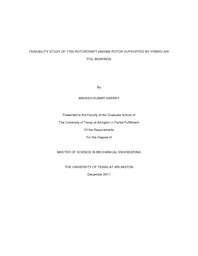
ATTENTION: The works hosted here are being migrated to a new repository that will consolidate resources, improve discoverability, and better show UTA's research impact on the global community. We will update authors as the migration progresses. Please see MavMatrix for more information.
Show simple item record
| dc.contributor.author | Varrey, Mahesh Kumar | en_US |
| dc.date.accessioned | 2012-04-11T20:54:43Z | |
| dc.date.available | 2012-04-11T20:54:43Z | |
| dc.date.issued | 2012-04-11 | |
| dc.date.submitted | January 2011 | en_US |
| dc.identifier.other | DISS-11458 | en_US |
| dc.identifier.uri | http://hdl.handle.net/10106/9526 | |
| dc.description.abstract | A potential solution towards light weighted and simple structured turbomachinery lies in elimination of oil-lubrication system. These promising benefits of oil-free turbomachinery have demanded extensive research in the field of small turbomachinery, leading to the development of different types of oil free bearings. Air foil bearings (AFBs) are one of the oil-free bearings with many advantages over others. AFBs have simple construction, greater service life and reduced maintenance. Their superior dynamic performance compared to traditional rigid surface bearings is an added advantage. Implementation of these foil bearings in the rotorcraft propulsion system decreases the total weight of the engine setup, improving its performance. In addition it aids to reduce emissions. This article is a feasibility study on compatibility of hybrid air foil bearings (HAFBs) with the T700 engine rotor under two different bearing designs. The HAFB was developed in Dr. Kim's laboratory over years, and HAFBs use external pressurized air supply during start/stop while they operate under either hydrodynamic condition or continuous hybrid mode at normal operating condition. The first design is with two 2 pad HAFBs and the second design is with two 3 pad HAFBs. A multi-degree of freedom (DOF) nonlinear rotordynamic analysis of a rigid rotor model supported by two HAFBs has been presented. The non-linear equations of motion of the rotor have been solved to determine translational and gyroscopic motions, and time dependent Reynolds Equation was used to obtain the dynamic reaction forces and moments from the HAFBs. A Visual C++ code has been developed to simulate the characteristic behavior of the rotor based on former discussed numerical model. The imbalance response for both in cylindrical and conical modes has been discussed. In addition, minimum film thickness of the bearings in both cylindrical and conical modes has been evaluated. | en_US |
| dc.description.sponsorship | Kim, Daejong | en_US |
| dc.language.iso | en | en_US |
| dc.publisher | Mechanical Engineering | en_US |
| dc.title | Feasibility Study Of T700 Rotorcraft Engine Rotor Supported By Hybrid Air Foil Bearings | en_US |
| dc.type | M.S. | en_US |
| dc.contributor.committeeChair | Kim, Daejong | en_US |
| dc.degree.department | Mechanical Engineering | en_US |
| dc.degree.discipline | Mechanical Engineering | en_US |
| dc.degree.grantor | University of Texas at Arlington | en_US |
| dc.degree.level | masters | en_US |
| dc.degree.name | M.S. | en_US |
Files in this item
- Name:
- Varrey_uta_2502M_11458.pdf
- Size:
- 1.514Mb
- Format:
- PDF
This item appears in the following Collection(s)
Show simple item record


